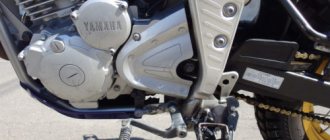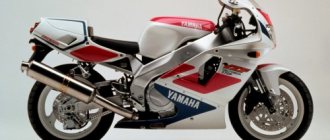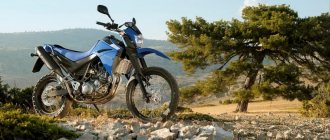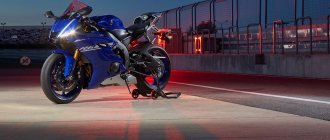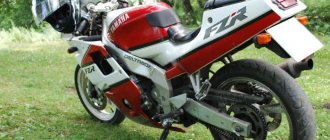| Yamaha MT-10 (FZ-10) 2016-2021 | Yamaha MT-10 SP 2017-2021 | Yamaha MT-10 Tourer Edition 2017-2020 |
| Yamaha MT-10 (2022+) | Yamaha MT-10 SP (2022+) |
Yamaha MT-10 naked bike model
was first announced at the end of 2015, and went into production in the spring of 2021. The reason for the appearance of this model was Yamaha’s desire to present to the market a flagship liter naked bike, which includes all the advanced technologies.
But why create another naked bike if there was already a Yamaha FZ-1 on the market? The fact is that the FZ-1 has practically not been updated since 2006, and therefore is quite outdated. In addition, 2015 was the last year of official sales of the FZ1 and it needed to be changed. Since the naked concept assumes the base of a sportbike, the “donor” Yamaha R1 of 2021 is radically different from that of the 2006 model, and Yamaha felt that it was time to update the top naked model and give the market not only a unique appearance, but also outstanding technical characteristics, which competitors don't. the Yamaha MT-10
was born .
In the North American market, the motorcycle was sold under the name Yamaha FZ-10
. However, by 2021 the name MT-10 was the main one in all sales markets.
The Yamaha MT-10 is based on the latest generation of the sports Yamaha YZF-R1, namely the engine, chassis, suspension and electronic systems.
The Yamaha MT-10 engine is a liquid-cooled inline 4-cylinder unit with a displacement of 998 cc. see, producing more than 160 hp. power and 111 Nm of torque. A special feature of the engine is the use of a cross-shaped crankshaft, which makes the power strokes uneven and allows for increased torque. Unlike the Yamaha YZF-R1, the MT-10 has more than 40 hp. weaker, but maximum torque became available at 9000 rpm.
The suspension and braking system are completely taken from the basic version, the only thing is that the suspension settings have been changed.
Among the electronic systems, it is worth highlighting the presence of the proprietary YCC-T system (electronic throttle), 3-level traction control, ABS, cruise control, slipper clutch, Yamaha D-Mode and QSS (quick shifter).
Thus, the Yamaha MT-10 significantly surpassed the current Japanese competitors, showing less weight and higher maximum power. Only the BMW S1000R and Aprilia Tuono V4R provide comparable performance.
In 2021, the MT-10 line will be replenished with two modifications - MT-10 SP
and
MT-10 Tourer Edition
. The main difference between the SP version and the base version is the presence of a color LCD panel and Öhlins electronic suspension (Electronic Racing Suspension (ERS)) - visually this modification is distinguished by a gold-colored fork. The Tourer Edition modification was distinguished by the presence of a touring body kit - glass, side cases, hand protection, a more comfortable saddle, a security system with GPS, and a 12V socket.
At the end of 2021, Yamaha introduced the new MT-10 and MT-10 SP for the 2022 model year. The updated versions have undergone a slight external restyling, the configuration of the front LED optics has changed, the LCD instrument panel has been replaced with a new 4.2-inch TFT color display in all versions, the engine has been updated (injection settings have changed, the intake and exhaust have been changed, maximum power increases 160 → 165.9 hp), models received a new 6-Axis IMU with new versions of the old ones + new electronic assistants.
Yamaha MT-10 / MT-10 SP: electronic equipment
- ABS
- Electronic throttle YCC-T (Yamaha Chip Controlled Throttle)
- Yamaha Chip Controlled Throttle (YCC-T) with Accelerator Position Sensor Grip (APSG) - 2022+
- D-MODE (3-mode)
- Full LED optics
- TCS (Traction Control System) (3-mode)
- Assist & Slipper clutch
- QSS (Quick Shifter System) up
- QSS (Quick Shifter System) up/down – 2022+
- Cruise control
- Electronic suspension Öhlinsn - MT-10 SP
- Yamaha Ride Control (YRC) 4-mode – 2022+
- Yamaha Variable Speed Limiter (YVSL) - 2022+
- SCS (Slide Control System) - 2022+
- Front wheel Lift Control System (LIF) – 2022+
- Engine Brake Management (EBM) - 2022+
- Brake Control (BC) System - 2022+
- 4.2′ TFT color display – 2022+
The main competitors of the Yamaha MT-10 in the class:
- Honda CB1000R
- Kawasaki Z1000
- Suzuki GSX-S1000
Brief history of the model
- 2016 - start of production and sales.
Model
: Yamaha MT-10 (FZ-10) (all markets).
Factory designation
: B671.
- 2017 - in addition to the main version, SP and Tourer Edition modifications are also offered.
Model
: Yamaha MT-10 (FZ-10) + SP (all markets).
Factory designation
: B672, B673, B674, B676, B678 + BW81, BW83.
- 2018 - The MT-10 name is now used in all markets (FZ-10 is no longer mentioned).
Model
: Yamaha MT-10 + SP (all markets).
Factory designation
: B67E.
- 2019 - no significant changes.
Model
: Yamaha MT-10 + SP (all markets).
Factory designation
: B67J.
- 2020 - no significant changes.
Model
: Yamaha MT-10 + SP (all markets).
- 2021 - no significant changes.
Model
: Yamaha MT-10 + SP (all markets).
- 2022 - restyling of the model. Second generation
.
Model
: Yamaha MT-10 + SP (all markets).
Pros and cons of Yamaha MT 10
Advantages
- Rich equipment is already included in the basic configuration . Here you have electronic gas, full-fledged traction control, an ABS system, cruise control, a quickshifter, and much more. The Yamaha MT 10 engine, by the way, can operate in three different modes. In general, the technical bells and whistles on this motorcycle would be enough for some small spaceship.
- Unsurpassed reliability typical of Yamaha motorcycles. No one has yet heard of any serious failures on the MT-10.
- Crazy acceleration dynamics , allowing you to leave even most liter sportbikes behind. Few people on the road can compete with this motorcycle on equal terms.
- Tenacious and effective brakes allow you to confidently control the situation.
- Spacious 17-liter gas tank . In general, the Yamaha MT 10 is quite economical if you drive quietly, but during aggressive driving with constant acceleration and braking of gasoline, it begins to consume an indecent amount of gasoline. The average gasoline consumption declared by the manufacturer is 8 liters .
- Comfortable straight fit without unnecessary strain on the arms and lower back.
Flaws
- Almost complete lack of wind protection . Already after 130-140 km/h, the oncoming evening begins to create serious inconvenience, especially if the pilot is above average height.
- High price . Well, what did you want? This is the flagship of the line! Moreover, used copies, which are still quite fresh, also cost decent money. Tuning from the official Yamaha catalog is also expensive.
- Nervous behavior at low speeds . In practice, this is expressed in the fact that when riding almost at idle, the bike reacts very sharply to the slightest turn of the throttle.
Specifications
Yamaha MT-10 Specifications:
| Model | Yamaha MT-10 |
| Motorcycle type | naked |
| Year of issue | 2016+ |
| Frame | aluminum Deltabox VI |
| engine's type | 4-cylinder, 4-stroke, in-line |
| Working volume | 998 cm³ |
| Bore/Stroke | 79.0 x 50.9 mm |
| Compression ratio | 12,0:1 |
| Cooling | liquid |
| Number of valves per cylinder | DOHC, 4 valves per cylinder |
| Fuel supply system | injector with YCC-T, x4 |
| Ignition type | TCI (digital) |
| Maximum power | 160.0 hp (118.0 kW) at 11500 rpm 165.9 hp (122.0 kW) at 11500 rpm - MT-10 (2022+) |
| Maximum torque | 111.0 Nm (11.3 kg*m) at 9000 rpm 112.0 Nm (11.4 kg*m) at 9000 rpm - MT-10 (2022+) |
| Clutch | Multi-disc in oil bath, cable drive |
| Transmission | 6-speed |
| type of drive | chain |
| Front tire size | 120/70 ZR17 M/C (58W) |
| Rear tire size | 190/55 ZR17 M/C (75W) |
| Front brakes | 2 discs, 320 mm, 4-piston radial calipers (ABS) |
| Rear brakes | 1 disc 220 mm, 1-piston caliper (ABS) |
| Front suspension | 43 mm inverted fork (fully adjustable), 120 mm travel Öhlins Electronic Racing Suspension (ERS) (MT-10 SP) |
| Rear suspension | pendulum with monoshock absorber (fully adjustable), travel - 120 mm Electronic suspension Öhlins Electronic Racing Suspension (ERS) (MT-10 SP) |
| Length | 2095 mm 2100 mm – MT-10 (2022+) |
| Width | 800 mm |
| Height | 1110 mm 1165 mm – MT-10 (2022+) |
| Wheelbase | 1400 mm 1405 mm – MT-10 (2022+) |
| Minimum ground clearance (clearance) | 130 mm 135 mm – MT-10 (2022+) |
| Seat height | 825 mm 835 mm – MT-10 (2022+) |
| Acceleration 0-100 km/h (0-60 mph) | 3.0 sec[1] |
| Maximum speed | 257 km/h[2] |
| Gas tank capacity | 17.0 l (including reserve - 4.0 l) |
| Motorcycle weight (curb) | 210 kg - MT-10 (2016-2021) 212 kg - MT-10 SP (2016-2021), MT-10 (2022+) 214 kg - MT-10 SP (2022+) |
Technical characteristics of Yamaha MT 10
For their flagship naked bike, Yamaha engineers did a great job, equipping the new product with the latest technology. In an alloy diagonal frame , hidden under the body kit, they placed a liter engine from a Yamaha YZF-R1, retuned and modified for better torque at mid-range speeds. The cross-shaped crankshaft , played a positive role in this . The technical characteristics of the Yamaha MT 10 are impressive - 160 hp. and 111 Nm of torque at 11,000 and 9,000 rpm, respectively . The curb weight is moderate - from 209 to 212 kg , depending on the configuration.
The Yamaha MT 10 received a 6-speed ; it was carried over to this bike from the YZF-R1 with virtually no changes. The dynamics of the motorcycle are hurricane, and the needle can go beyond the 100 km/h mark already in first gear, and with a sharp opening of the gas the bike can be lifted onto the rear wheel even in third or fourth gear. But, like other wet sump motorcycles, the Yamaha MT 10 does not like long wheelies - this can lead to oil starvation of the engine . However, even without such extreme sports, the MT 10 can deliver so much adrenaline that after the trip you will have to wash your pants.
braking system matches its acceleration dynamics - two 320 mm discs at the front and 220 mm discs at the rear , and the ABS system is already included as standard. But you need to monitor road irregularities very closely, since the rigid and informative suspension is not very energy-intensive, and every hole on the asphalt is immediately felt very strongly. In addition, the ground clearance of the Yamaha MT 10 without load does not exceed 13 cm, so even asphalt speed bumps in some cities can become a problem.
Total
Motorcycles like the Yamaha MT 10 are not created for speed records, although they can handle them too. Their task is simple - to give the owner as much adrenaline as they can bear . Of course, no one forbids using this bike as everyday transport in the warm season, but this will mean using its capabilities only by a third, or even a quarter. Convenient and comfortable by the standards of the class, the Yamaha MT 10 should not sit in a garage and carefully filter through traffic jams; its character is revealed only when it roars into a turn with a speed of 200 km/h on the speedometer. This is a motorcycle for pure pleasure. Maybe not too practical, but still great in every way.
Reviews from Yamaha MT 10 owners
This is really not a motorcycle, but a monster; turning the handle teleports you into orbit. I switched to the MT10 from a liter CBR, but I didn’t expect such agility, the bike is really nervous, it requires brains and experience. Out of habit, in the first days I almost got into a wheelie several times until I got used to controlling the wheelie. On the highway I accelerated to 190, there was no opportunity to check further, but it felt like there was still a lot of reserve there. In general, the toy is not for the faint of heart, and not for beginners, that's for sure. Grigory, Nizhny Novgorod, Yamaha MT 10 '2017.
Rocket without plastic, I used to drive a 2009 R1, I drove it to the track periodically, but in the end I was tempted and bought an MT-10. In short, I don’t regret it, the dynamics are crazy plus full control at any speed. Pavel, Moscow, Yamaha MT 10 '2016.
The toy is expensive, but then you understand what every ruble is paid for. I compared it with a friend’s liter GSR and with a Ducati Diavel, Yamaha beats both. It rides nose to nose with the GSR, but it brakes more confidently, plus it feels like it steers better, and it’s much more comfortable to sit on. My personal record is modest - 7 hours in the saddle with stops for refueling, almost without getting tired. I warmed up a little, and I could move on. Victor, Moscow, Yamaha MT 10 '2017.
Similar models
- Suzuki GSR1000 . This naked kit equipped with a 182-horsepower engine can easily compete with the Yamaha MT 10 in a number of parameters.
- Kawasaki Z1000. Another street fighter, the product of a masterly symbiosis of Kawasaki engineers and designers, who managed to create one of the most technologically advanced and stylish motorcycles of our time.
- Aprilia Tuono V4 1100RR . A very interesting Italian, incredibly powerful and also has good wind protection for a naked bike.
- BMW S1000R . A combination of Bavarian high technology, high prices and signature BMW reliability.
- Honda CB1000R . A more classic motorcycle in appearance, powerful, unusual and, at a minimum, worthy of attention.
Compact transmission The pyramidal arrangement of the input and output shafts of the 6-speed transmission makes the engine extremely short, due to which the developers have achieved an optimal position of the engine in the frame in terms of weight distribution of the motorcycle.
Innovative Valve Train Drive The Yamaha MT-10's valve train is designed to lift the valves higher and stay open longer for added power and less stress on the springs, extending their life.
More air in the lungs The huge 12-litre airbox gives the engine more oxygen to make riding the Yamaha MT-10 easy and comfortable. The 12-nozzle injectors are angled to optimize the flow of mixture into the combustion chamber.
Easy Exhaust The MT-10 exhaust system is made from stainless steel and titanium and features an EXUP® valve to control backdraft, improving engine efficiency throughout the range.
Slipper Assist Clutch Yamaha's assist clutch makes the lever easier to operate, and the slipper function helps prevent the rear wheel from locking up when downshifting.
Sensitive Traction Control System (TCS) helps the Yamaha MT-10 rider feel comfortable on any road surface by modulating parameters such as ignition timing, air-fuel mixture and throttle opening. Yamaha's TCS has three levels of engagement, plus an option to switch off.
Crossplane Technology Huge potential lies within the Yamaha MT-10 engine, which also powers the flagship YZRR1M motorcycle. A key feature is the Crossplane crankshaft, designed to reduce the internal moment of inertia in the engine, resulting in a virtually direct connection between the accelerator and instantaneous acceleration, without delay.
Cruise control as standard One of the features of the Yamaha MT-10 with the YCC-T system is the presence of full cruise control, the control of which is located on the left remote control.
Latest generation CP4 engine 998 cc inline 4-cylinder engine. with a transverse crankshaft and titanium split connecting rods, 160 hp. - the first serial product in the history of the industry, born in the Big Prizes, provides the Yamaha MT-10 with the highest power and linear increase in torque. The CP4 engine is tuned specifically for street and highway driving and provides optimal low-end and mid-range response.
Top-end set of control electronics The Yamaha MT-10 engine control system is built on the ride-by-wire principle and Yamaha Chip Controlled Throttle (YCC-T®) technology, electronic throttle control. Thanks to YCC-T, the driver can choose how aggressive the 998cc engine's throttle response is by switching between D-Modes: Mode 1 for the sharpest power delivery, Mode 2 for relaxed everyday driving and Mode 3 for the smoothest power delivery. driving, with a progressive increase in power.
Shift up without using the clutch The Yamaha MT-10 is equipped with a quick shifter (QSS) that allows you to shift up without having to press the clutch and close the throttle.

